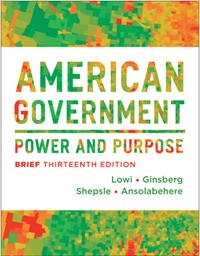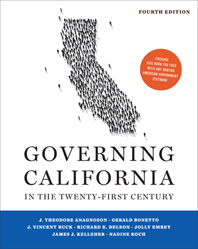Course Information
- Political Science 355
- Mondays and Wednesdays 12:30PM-1:45PM at Jerome Richfield 315
- Moodle will also be used as the course learning management system (http://moodle.csun.edu)
Course Description
The University Catalog describes this course as "a detailed study of the structures and functions of the national government and California state and local governments. Special attention is given to the legislative and executive branches in the policy-making and administrative processes as well as the constitutional bases for these processes". This course also satisfies your Title 5 requirement for American history and government.
Student Learning Objectives
According to the University catalog, “Courses in the US History and Local Government (Title V) section must meet the Title V requirements as prescribed by California law.
Goal: Students will understand and reflect upon United States history, institutions, and ideals; the Constitution of the United States; and the principles of state and local government as established in California.”
GE and Title V Student Learning Outcomes
- Describe and analyze the histories of the United States and California over significant time periods
- Explain the principles and major provisions of the Constitutions of the United States and California
- Compare United States and California political institutions and practices
- Describe and examine the histories and development of political institutions as related to diverse peoples in the United States and California.
Departmental Student Learning Objectives
- Active Citizenship and Civic Engagement – Students should demonstrate a knowledge and awareness of contemporary issues, political institutions, and problems in the community and their historical contexts. Students should demonstrate an understanding of the importance of community involvement and leadership.
- Assessment criteria for graded assignments – Evidence suggests that student is able to identify a major political and/or policy problem and is able to conceptualize and analyze the causes of the policy issues
- Political Decision Making – Students should demonstrate an in-depth understanding and knowledge of the political institutions through which public policies are formulated, modified, and implemented.
- Assessment criteria for graded assignments – Evidence suggests student is able to identify political issues and link them to the institutions involved in solving these issue
Course Requirements & Grading
Please see the Course Schedule below for the specific dates and mark your personal calendars in advance since make-up exams will not be permitted. There will be five exams in the course, two short papers and a final paper.
Paper Assignments
Students will be expected to submit two short papers as well as a final paper. Each paper is expected to be a well thought-out and researched response to the question posed (See topics below). The short papers should be between 3-4 pages long and the final paper being 6-7 pages long. Make sure to include academic references as well as utilize proper APA format. You will have the option of rewriting one of your short papers for a higher grade after initial comments and grading.
We will discuss the papers in class during the semester including the grading rubrics. The rubrics will also be posted in the course Moodle site.
Paper 1 Topic: Americans share the basic beliefs that comprise American political culture yet disagree on many issues along the lines of class, race, gender, and religion. Take two basic American beliefs (e.g. democracy, individualism, equality, community, etc.) and show how each can be interpreted differently depending on one’s distinctive identity.
Paper 2 Topic: Although legal obstacles to voting have been dismantled, fewer people vote today than thirty, forty or even fifty years ago. Why is this the case?
Final Paper Topic: An interesting aspect of American politics concerns the ways in which political conflicts have been transformed into constitutional struggles over federalism. Analyze the debate over states’ rights versus national supremacy from the founding of our nation up until today. How has this debate changed over time?
Exams
You will have five exams in the class. Your lowest score will be dropped with only four of the exams counting towards your final grade. The exams will be based on the reading and class lectures. Each exam will be a combination of true/false, multiple choice, and fill-in the blank questions.
Attendance
I will randomly take role and call out a few student names. If you are not present when your name is called, then you will loose attendance points.
The grading will be broken down as follows
| Exam 1 | 12 |
| Exam 2 | 12 |
| Exam 3 | 12 |
| Exam 4 | 12 |
| Paper 1 | 12 |
| Paper 2 | 12 |
| Final Paper | 20 |
| Attendance | 8 |
*There will be no extra credit or make-up work available in the course. Make sure to mark your personal calendars in advance since the due dates are not negotiable.
Percentage |
Grade |
95-100 |
A |
90-94 |
A- |
87-89 |
B+ |
83-86 |
B |
80-82 |
B- |
77-79 |
C+ |
73-76 |
C |
70-72 |
C- |
67-69 |
D+ |
63-66 |
D |
60-62 |
D- |
0-59 |
F |
Course Schedule
Dates |
Reading, Exams, and Papers |
| M-8/25 | Introduction |
|
W-8/27 |
Lowi et al.
*Campus closed for Labor Day on 9/1 |
M-9/15 |
Exam 1 |
W-9/17 |
Lowi et al.
Additional reading will be available on Moodle on same-sex marriage, torture, and the death penalty |
|
W-10/1 |
Exam 2 |
M-10/6 |
Lowi et al.
|
M-10/20 |
Exam 3 |
|
W-10/22 |
Lowi et al.
Anagnoson et al.
|
W-10/29 |
Paper 1 |
M-11/3 |
Lowi et al.
Anagnoson et al.
|
W-11/12 |
Paper 2 |
W-11/19 |
Exam 4 |
M-11/24 |
Anagnoson et al.
|
M-12/8 |
Exam 5 |
M-12/15 |
Final Paper |
If you are interested in printing the syllabus, you may access the PDF here.
At any time this syllabus may be amended or revised. Students will be notified if any changes are made.


